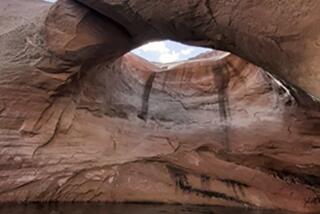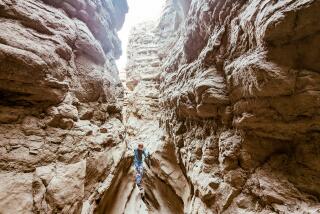Utah’s Home of the Golden Arches : National Park Is Renowned for Sandstone Formations
- Share via
ARCHES NATIONAL PARK, Utah — At the Fiery Furnace parking lot at the foot of a chaotic jumble of weird-shaped rocks, spires and pinnacles, a National Park sign cautions:
We have this problem. People get lost down there in the Fiery Furnace. There is no trail. So, we put up a sign ‘Do Not Enter!’ They enter anyway. Join a ranger-led nature walk. Don’t get lost in the Fiery Furnace.
Arches National Park, 114 square miles in southeastern Utah, has the greatest concentration of natural stone arches on earth. Many of the arches are in the Fiery Furnace, so named because during spectacular sunsets its sandstone formations resemble flames leaping skyward.
“It is a challenge to get in the Furnace, a challenge to get out of the Furnace,” said Damian Fagan, 26, a ranger who leads hikes through the labyrinthian maze.
Ready for the challenge was a group of intrepid hikers, including Dick Thymeson, 68, and his wife, Kitty, of Fort Lauderdale, Fla.
“We started into the Fiery Furnace on our own when we were here last year, but had second thoughts, sensing immediately that there were too many chances of getting lost,” said Thymeson. “So, we chickened out.”
“Wise decision,” chimed in the tall, blond ranger, now in his fourth summer leading walks into the Fiery Furnace.
Fagan led the group over boulders, through narrow openings and between the free-standing rock walls called fins.
Footprints of fox and coyote etched the red sandy soil. Ravens and chittering white-throated swifts flew in and out of narrow openings in the rock.
Hikers soon encountered Jug-handle Arch, then Skull Arch, a huge double arch that resembled eye sockets in a giant skull, Flat Iron Arch and Kissing Turtles Arch.
More Being Discovered
“More and more arches are being discovered all the time,” the ranger said. “The August, 1947, National Geographic reported 83 arches in the park. By 1982 the 200th arch was recorded. In the last four years, 325 new arches have been found for a total now of 525.”
Fagan noted that an opening in a rock is considered an arch if it has a diameter of at least three feet.
“How do people keep finding new arches?” asked Carol Ridder, 36, a Minneapolis housewife on the hike with her husband, Ken, 39, and their two children, Jennifer, 6, and Steven, 10. “You would think the arches would all have been discovered by now.”
“People just keep finding them,” Fagan said. “Everyone who works here tries to find new ones and visitors hiking around happen upon arches that have been overlooked.”
Fagan says he has discovered four arches during his four years here. He called them Burnt Ceiling Arch, Sink Arch, Grasshopper Arch and Demon Arch, the last one a takeoff on his first name.
‘Brewed for Tea’
“These gnarled old Utah juniper trees are 200 to 300 years old,” Fagan said, describing the flora and fauna. “They often fall over and continue to live and grow. That plant over there is called Mormon tea. It is brewed for tea, used to cure colds and congestion.”
The arches are formed over the centuries by weathering and eroding action of water, ice, wind and extreme temperatures, he explained. “The power of erosion will eventually wear away arches we see today and new ones will be formed. However it takes hundreds, thousands of years. It took millions of years for nature to carve out these formations.”
After two hours in the Fiery Furnace, the ranger led the group safely out of the rock maze and the hikers scattered in a number of directions to hike on their own through other parts of the park. Awaiting them were other arches, including Eye of the Whale, Double O, Partition, The Spectacles--two huge side-by-side windows--and Landscape Arch. The latter spans 291 feet and is 105 feet high, making it one of the largest natural stone arches in the world.
More to Read
Sign up for The Wild
We’ll help you find the best places to hike, bike and run, as well as the perfect silent spots for meditation and yoga.
You may occasionally receive promotional content from the Los Angeles Times.






